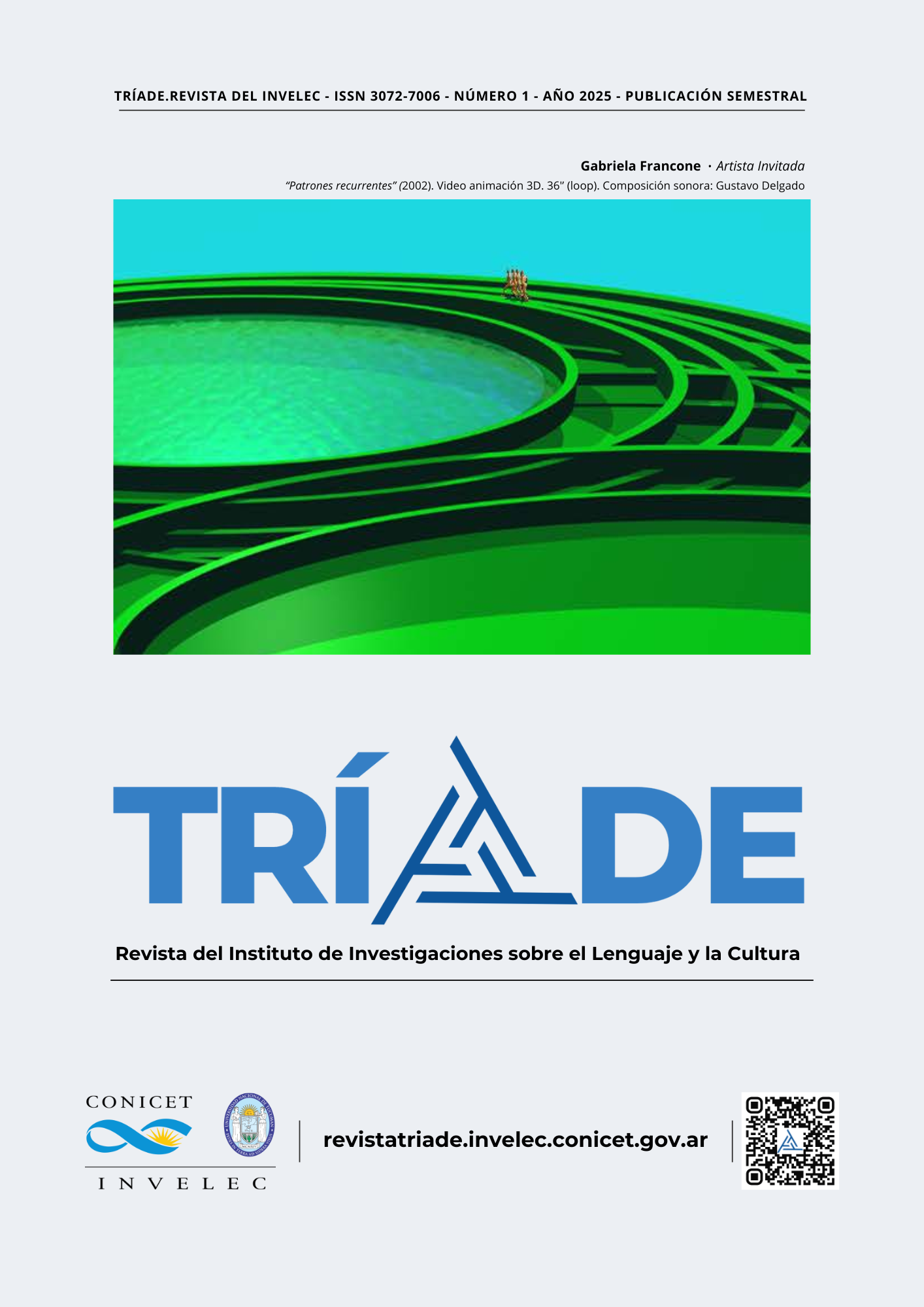Naked: The corporal spectacles and the dislocation of exile in Libro de Manuel by Julio Cortázar and La nave de los locos by Cristina Peri Rossi

Downloads
DOI:
https://doi.org/10.59516/invelec.triade.N1.24Keywords:
Julio Cortázar, Cristina Peri Rossi, politics of space, body, exileAbstract
Julio Cortázar and Cristina Peri Rossi are two Latin American mid-twentieth century writers who were close friends and enjoyed an ongoing personal correspondence, including published poetry and essays dedicated to one another. This essay explores a fictional correspondence between them by comparing the striptease scenes in two of their novels, Cortázar's Libro de Manuel and Peri Rossi's La nave de los locos. Both novels feature expatriate and exiled characters in European cities who perform in or become spectators of striptease shows held at clubs in gritty urban surroundings. Although some ten years separate the novels' publication, the significance of these scenes in their respective novels suggests some heretofore unexplored themes in their shared preoccupation with urban space, exile and displacement, political resistance, gender transgression, sexuality and the body. Rereading these scenes alongside feminist, gender, and performance studies theory from the decades in which the novels appeared, as well as in light of more recent theories on cross-dressing, trans performance and globalization, uncovers new dimensions in the politics of space, the body, exile and belonging in their work.
References
Aguirre, Carlos, Gerald Martin, Javier Munguía, y Augusto Wong Campos (eds.) (2023). Las cartas del Boom. Julio Cortázar, Carlos Fuentes, Gabriel García Márquez, Mario Vargas Llosa. Barcelona: Alfaguara.
----- (2023). “Introducción”. Las cartas del Boom. Julio Cortázar, Carlos Fuentes, Gabriel García Márquez, Mario Vargas Llosa (pp. 13-35). Barcelona: Alfaguara.
Augé, Marc (2000). Los “no lugares”: espacios del anonimato. Una antropología de la Sobremodernidad. (Margarita Mizraji, trad.). Barcelona: Gedisa.
Boal, Augusto (2009). Teatro del oprimido. (Graciela Schmilchuk, trad.). Madrid: Alba.
Bullough, Vern L. y Bonnie Bullough (eds.) (1993). Cross Dressing, Sex, and Gender.
Pennsylvania: University of Pennsylvania Press.
Butler, Judith (2002). Cuerpos que importan. Sobre los límites materiales y discursivos del ‘sexo’. (Alcira Bixio, trad.). Buenos Aires: Paidós.
----- (1990). “Performative Acts and Gender Constitution: An Essay in Phenomenology and Feminist Theory.” En Sue-Ellen Case (ed.) Performing Feminisms: FeministCritical Theory and Theatre (pp. 270-282). Baltimore: Johns Hopkins.
Case, Sue-Ellen [1985] (1996). De “Classic Drag: The Greek Creation of Female Parts”. En W.B. Worthen (ed.) The Harcourt Brace Anthology of Drama. Segunda edición (pp. 107-113). Fort Worth: Harcourt Brace.
Cochrane, Helena Antolin (1997). “Androgynous Voices in the Novels of Cristina Peri Rossi.” Mosaic, pp. 97-114.
Cortázar, Julio (2012). Cartas. 5 vols., editado por Aurora Bernárdez y Carles Álvarez Garriga. Madrid: Alfaguara.
----- [1973] (1983). Libro de Manuel. Barcelona: Bruguera.
----- (1984). Salvo el crepúsculo. México: Nueva Imagen.
Davy, Kate (1992). “Fe/male Impersonation: The Discourse of Camp.” En Janelle G. Reinelt y Joseph R. Roach (eds.) Critical Theory and Performance. Michigan: University of Michigan Press, pp. 231-247.
Dolan, Jill (2012). The Feminist Spectator as Critic. University of Michigan Press.
Duncan, Nancy (ed.) (1996). Bodyspace: Destabilizing Geographies of Gender and Sexuality. London: Routledge.
----- (1996). “Renegotiating Gender and Sexuality in Public and Private Spaces.”Bodyspace: Destabilizing Geographies of Gender and Sexuality. Routledge, pp. 127-45.
Fraser, Mariam y Greco, Monica (eds.) (2005). The Body: A Reader. London: Routledge.
Foster, Timothy (1997). “Transgressions in Literature, Politics and Gender: Peri Rossi’s La nave de los locos.” Confluencia, vol. 13, no. 1, pp. 73-83.
Gambaro, Griselda (1981). “El despojamiento.” Tramoya, n° 21-22, pp. 119-28.
Garber, Marjorie (1992). Vested Interests: Cross-Dressing and Cultural Anxiety. New York: Routledge.
Garner, Stanton B., Jr. (1994). Bodied Spaces: Phenomenology and Performance in Contemporary Drama. Ithaca: Cornell University Press.
Published
Issue
Section
License
Copyright (c) 2025 Marcy Schwartz (Autor/a)

This work is licensed under a Creative Commons Attribution-NonCommercial-NoDerivatives 4.0 International License.
Aquellos/as autores/as que tengan publicaciones en esta revista aceptan los términos siguientes:
Los/as autores/as conservarán sus derechos de autor y garantizarán a la revista el derecho de primera publicación de su obra, el cual estará simultáneamente sujeto a la Licencia Creative Commons Atribución-NoComercial-CompartirIgual 4.0 Internacional (CC BY-NC-SA 4.0), que permite a terceros utilizar lo publicado, siempre que se otorgue el adecuado reconocimiento; se mencione la autoría del trabajo y la primera publicación en Tríade; no se haga uso del material con propósitos comerciales; y, en caso de crear otro trabajo a partir de material original (por ejemplo, una traducción), debe distribuir su contribución bajo esta misma licencia del original.
Los/as autores/as podrán adoptar otros acuerdos de licencia no exclusiva de distribución de la versión de la obra publicada (por ejemplo, depositarla en un archivo telemático institucional o publicarla en un volumen monográfico), indicando los datos de su publicación inicial en esta revista.
Se permite y recomienda a los/as autores/as difundir su obra a través de Internet (por ejemplo, en archivos telemáticos institucionales o en su página web) después del proceso de publicación, lo cual puede producir intercambios interesantes y aumentar las citas de la obra publicada. (Véase El efecto del acceso abierto).
How to Cite
Similar Articles
- Sonia Jostic, A logic of extravagance: About Conjunto Vacío by Ver{onica Gerber Bicecci , TRÍADE : No. 1 (2025): Tríade
- Olivia Narcisa Petrescu, Romanian exiles and cultural crossroads in Argentina during the Cold War , TRÍADE : No. 1 (2025): Tríade
- Fernando Degiovanni, The body-lab: experimentation and somatopolitic desertion in NorahLange , TRÍADE : No. 1 (2025): Tríade
- Carmen Perilli, Children Steps in the Desert: Valeria Luiselli , TRÍADE : No. 1 (2025): Tríade
You may also start an advanced similarity search for this article.


